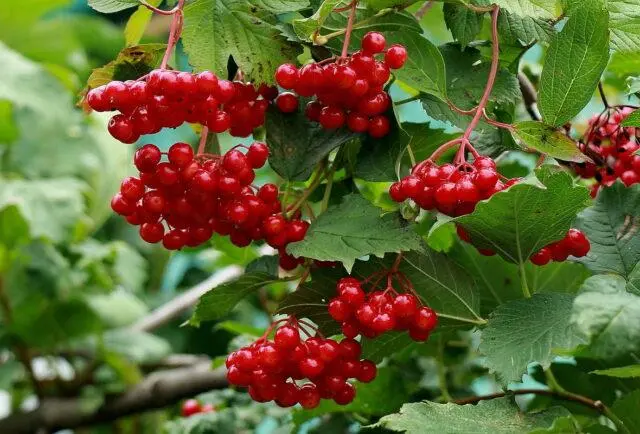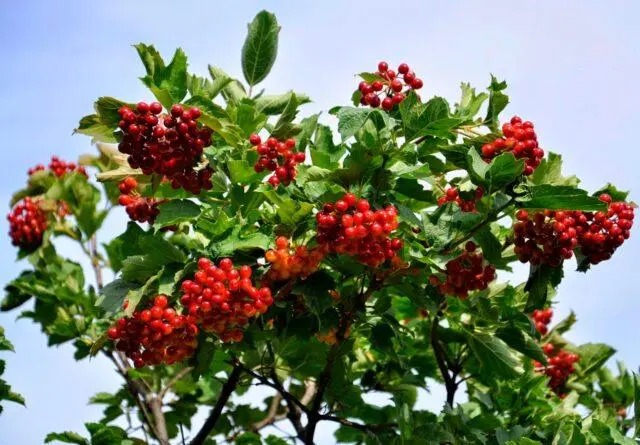Contents
Pruning the common viburnum is designed to give it a great decorative effect, because in nature this culture can most often be found in a tall form. There are several types of pruning, each with a specific purpose and timing.
Is it possible to cut viburnum
Despite the fact that viburnum is an ordinary initially wild-growing crop, today it can be found in household plots and adjacent territories. The “wild” origin of viburnum makes itself felt through the constant formation of root shoots and active thickening of the branches.
Feralization of culture leads to shading of the lower tier, interlacing of lateral branches and clogging of the bush with uncontrolled root shoots. As a result of lack of lighting, ventilation and high humidity, a comfortable environment is formed for the development of fungal and bacterial diseases.
It is necessary to trim the viburnum not only in order to give it an aesthetic appearance and protect it from fungus damage, but also in order to preserve the future harvest.

Proper care will extend the life of viburnum up to 25 years
When to prune common viburnum
Pruning of the common viburnum can be carried out in autumn, spring and summer, and yet it is the autumn formation of the bush that is preferable. The fact is that during this period sap flow stops, leaves fall and the culture begins to prepare for wintering. In autumn, sanitary pruning is carried out, during which diseased dried and damaged branches are cut.
Too intensive formation of viburnum vulgaris can lead to freezing in the cold season, so on the eve of winter you should not cut the bush too much.
In the spring, a shaping and rejuvenating procedure is carried out. In the first four years, when the culture grows most intensively, it is necessary to cut the viburnum. In the subsequent time, it is enough to maintain the aesthetic state of the green crown.
Is it possible to cut the viburnum in the summer
Many novice gardeners are concerned about the question of whether it is possible to trim the common viburnum in the summer. This period is suitable for thinning the crown and getting rid of dense areas that may contain aphids and other pests.
Rules and schemes for pruning viburnum
The types of pruning of common viburnum depend not only on the variety, but also on the age of the plant. So, the seedling must be given time to adapt and successfully root. On average, this period is two years. During this period, young shoots are only pinched, and a full-fledged formative pruning is carried out in the third year.
For adult bushes of common viburnum, a thinning and rejuvenating formation is organized. Be sure to remove branches growing inward, vertically, crosswise, as well as second-order shoots.
Also, all stems are regularly shortened by one length and cut off the lower basal shoots. This allows you to maintain the aesthetic shape of the bush.
When planting a young seedling in autumn, it is necessary to cut off almost all of its shoots, leaving a couple of buds directly above the ground. The stems sprouted next year are pinched at the top level, leaving a length of no more than 30 cm.

Viburnum vulgaris bears fruit on annual growths
All root shoots must be cut out, but the strongest shoots are left and shortened by about a third. This stimulates lateral branching and allows you to give the viburnum bush the desired shape. This procedure is carried out annually.
In addition to the growth of side branches, it is necessary to control the main central shoots. To do this, they are allowed to reach the desired length, after which they are limited in growth, that is, they are trimmed.
The autumn formation algorithm is the following sequence of actions:
- Remove weak branches that cannot withstand the weight of the snow.
- Trim dried shoots.
- When forming, the cut should be made directly above the kidney so that it is directed “away from the bush”.
- Cut off the broken branch “under the stump”.
- All sections larger than 1 cm must be processed – covered with garden pitch.
There is nothing complicated in the haircut of the common viburnum. Even a novice gardener can carry out this procedure.
What tools and materials will be required
Before work, it is necessary to prepare special cutting tools. It can be a saw, lopper or pruner. Each gardener decides for himself what is more convenient. It is desirable that the blade of the knives be made of high-quality steel. This will protect the tool from premature rust.
Before starting the procedure, the instruments must be sharpened well and treated with alcohol for additional disinfection. To protect the cuts, use a special putty or garden pitch.
How to prune a viburnum bush
There are several varieties of pruning common viburnum. The choice of the optimal type of shaping depends on the variety, goals and time of year.
Sanitary pruning
Sanitary pruning is carried out after the end of the harvest. To do this, remove the following types of branches:
- broken;
- diseased;
- dried up;
- not fallen bunches of berries.
During the autumn formation, you should not remove too many branches, otherwise this will lead to a decrease in frost resistance.
Thinning crop
In the summer, the common viburnum is trimmed to prevent thickening of the branches. The best time for the procedure is the moment after the appearance of the leaves, when the ovaries of future inflorescences have not yet formed.
To carry out pruning, it is necessary to carefully examine the bush, find all the thickened areas and remove excess branches. First of all, shoots growing inward and upward are cut off. Also remove branches that are too close to each other.
Rejuvenating pruning of old viburnum
The lack of regular formation affects not only the appearance of the common viburnum, but also its fruiting. Developmental delay can be observed at the sixth year. Pruning viburnum in the fall is aimed at rejuvenating the culture.
Overgrown branches are gradually removed by sawing them under the root with a garden saw. About one or two old branches are cut a year, no more. This procedure allows you to rejuvenate the bush and stimulate future crops.

With proper pruning, old shoots will be replaced by strong young growth.
The average rejuvenation period is two to three years. During this period, the common viburnum bush will be able to completely renew itself.
In some cases, it is impossible to rejuvenate viburnum. If there are too small fruits on the bushes for two years, then this indicates that the plant is already over 25 years old, so there is no point in rejuvenating pruning. In this case, it is more expedient to uproot the culture.
When forming a common viburnum in the form of a tree, the entire trunk is cut down, leaving several processes of basal shoots, after which they are re-grown and a culture is formed.
Formation in the form of a bush
The main task when pruning in the form of a bush is to preserve the splendor and multi-stem culture. Viburnum ordinary is convenient in terms of shaping. A secateurs will be enough to give the plant the desired shape.
With bush pruning, the lower tier of branches is cut out, then wilted inflorescences. Completely remove shoots whose growth is directed inward or upward. In this case, the cuts should be located above the nodes, from which flowers should appear next year.
When “bald patches” are found in the bush, a branch is found growing in the direction of this “hole”, after which it is cut so that the growth of the kidney is directed to an empty place. The next year, after a new shoot appears, this defect will be eliminated.
Pruning viburnum and forming it in the form of a bush is associated with the regular removal of basal shoots. Of the central shoots, seven to eight of the strongest are left, after which the growth of lateral branches is directed. They are trimmed to the correct length every year. This method of formation is optimal for a fruit-bearing crop.
Tree shaping
When forming in the form of a tree, root shoots must be removed almost completely. The central trunk is left, and the crown is given the desired shape over time. Most often it is round. The tree shape is more decorative. In addition, thanks to her, the common viburnum takes up much less space on the site.
In some cases, especially with a heavy harvest and foliage, the crown can be so heavy that it will damage the trunk. The problem is solved by installing additional props.

The yield of common viburnum in the form of a tree is lower than that of a crop cut in the form of a bush
Care after pruning
After the shaping procedure, it is necessary to treat all fresh sections with a solution of copper sulfate and allow them to dry well. Only after that they can be “closed” with garden pitch.
When pruning common viburnum in dry and hot weather, the culture must be well watered, since the shaping procedure is stressful for the plant.
Conclusion
Pruning common viburnum is a very simple and common procedure aimed at creating a decorative look and preserving the quality of the crop. It needs to be done regularly. Only in this case, the bush or tree will delight the owner with lush flowering and healthy berries.









